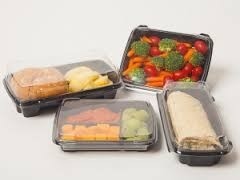
PVC was one of the first polymers used in food packaging. It replaced many traditional materials such as glass as well as various forms of card and paper due to its qualities of being lightweight, shatter-resistant, organoleptic, cost-efficient, effective barrier, printable on, easily moldable and transparent.
PVC can be used with a wide range of additives making its applications diverse. In the packaging industry, it is used to package food through the forms of rigid thermoformed sheets and containers as well as soft cling films. It is also used in adhesive tapes, pharmaceutical tablet blisters, bottle sleevings, disposable syringes packaging which allows radiation sterilization.
Up until 2020, PVC was approved for use in food packaging in most countries even though its use was significantly reduced after a decade of emerging single-use plastic bans. The truth is, even though it is mechanically recyclable, very few facilities exist where they process PVC.
In recent times, regulatory bodies have become increasingly aware of the negative impacts of PVC manufacturing and use. Global PVC industries have had adverse impacts such as:
- Ozone depletion due to the release of carbon tetrachloride
- Contamination of air and drinking water
- Contributions to climate change and environmental degradation by burning of fossil fuels to produce chlorine or coal-intensive acetylene-route PVC
It has also caused human exposure to harmful substances such as:
- Carcinogenic vinyl chloride monomer
- Bioaccumulative toxics like mercury, dioxins, and furans
- Community and worker exposure to asbestos for chlorine production
- Plastic pellet and mercury contamination of waterways from dumping chemical waste
Rwanda was the first country to eliminate the use of PVC as part of being completely plastic-free in terms of packaging by 2009.
In January 2020, South Korea banned PVC under regulations banning the use of “hard-to-recycle” plastic materials for F&B packaging.
Taiwan’s EPA and India’s Environment, Forest and Climate Change Ministry followed in 2021.
Soon, it can be expected to see no traces of PVC in at least food packaging in the interests of both the environment and human health.




